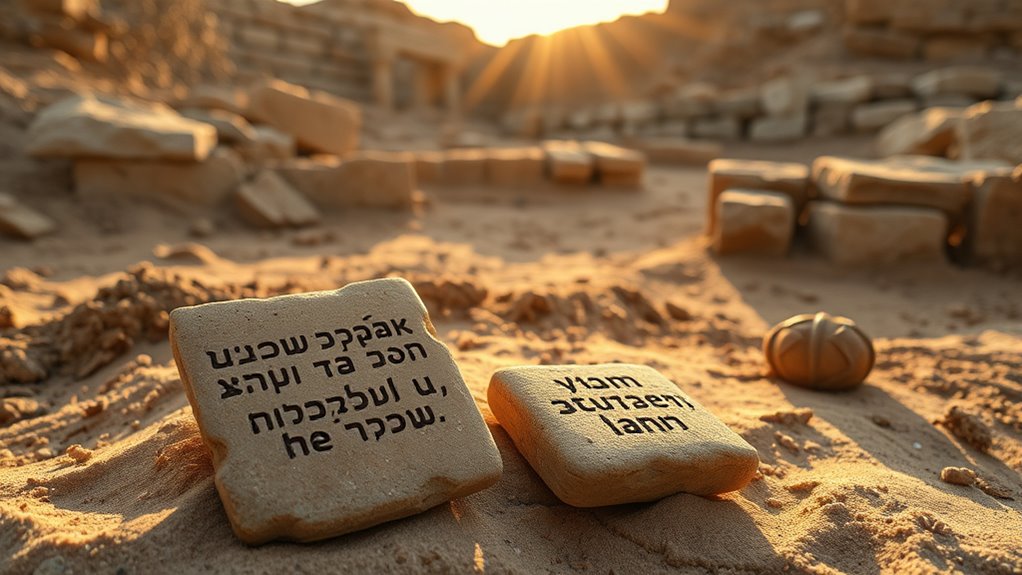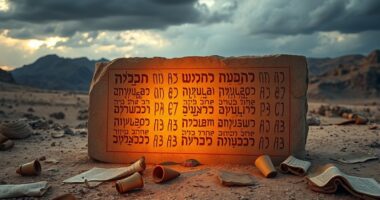Archaeology provides strong evidence supporting many biblical sites, cities, and figures, confirming their historical existence. Discoveries at places like Jericho and Hebron match biblical descriptions, giving you tangible proof. However, some findings raise questions about biblical timelines, and interpretative challenges exist. Overall, archaeology largely validates key parts of the biblical narrative, though it also prompts further inquiry. Exploring this topic more can help you better understand how science and faith intersect.
Key Takeaways
- Archaeological discoveries have confirmed the existence of many biblical sites like Jericho and Hebron.
- Artifacts such as inscriptions and pottery support biblical narratives and historical figures.
- Excavations have validated the locations of key biblical cities and events.
- Some findings challenge biblical timelines, prompting re-evaluation of historical assumptions.
- Archaeology both supports and complicates the historical accuracy of the Bible, depending on the discovery.
Key Biblical Sites Confirmed by Archaeology
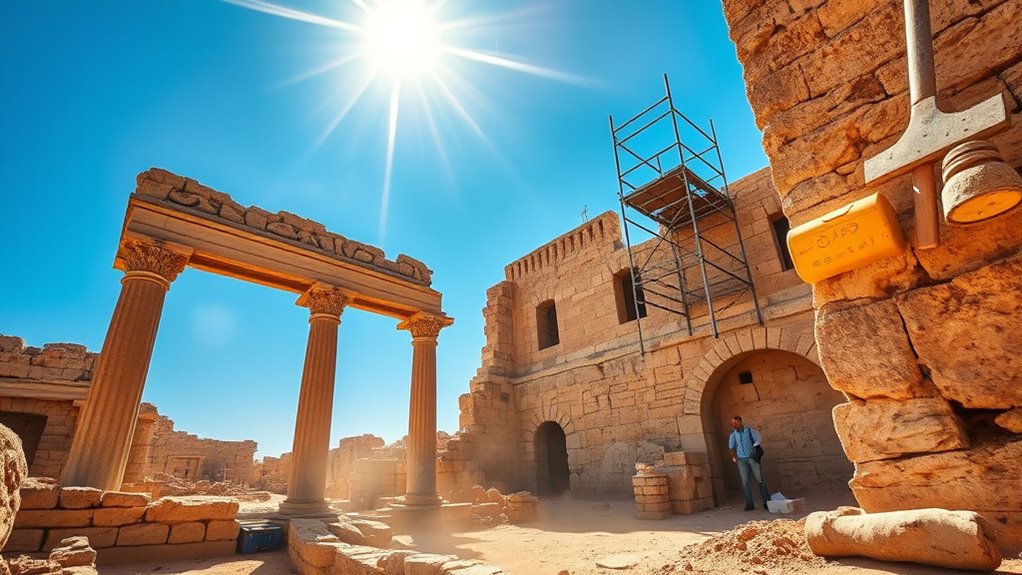
Many key biblical sites have been confirmed through archaeological discoveries, providing tangible evidence that supports biblical accounts. When you explore these sites, you’ll find ancient artifacts that match descriptions in historical texts. For example, excavations at Jericho uncovered ancient walls and tools, aligning with biblical stories of its conquest. Similarly, finds at Hebron include pottery and inscriptions dating back thousands of years, confirming its long-standing significance. These artifacts help piece together the historical context behind biblical narratives. They serve as physical proof that these locations existed and played fundamental roles in biblical history. By studying these discoveries, you gain confidence that the biblical accounts have roots in real, verifiable history, bridging the gap between faith and archaeological evidence.
Archaeological Evidence of Biblical Cities and Events
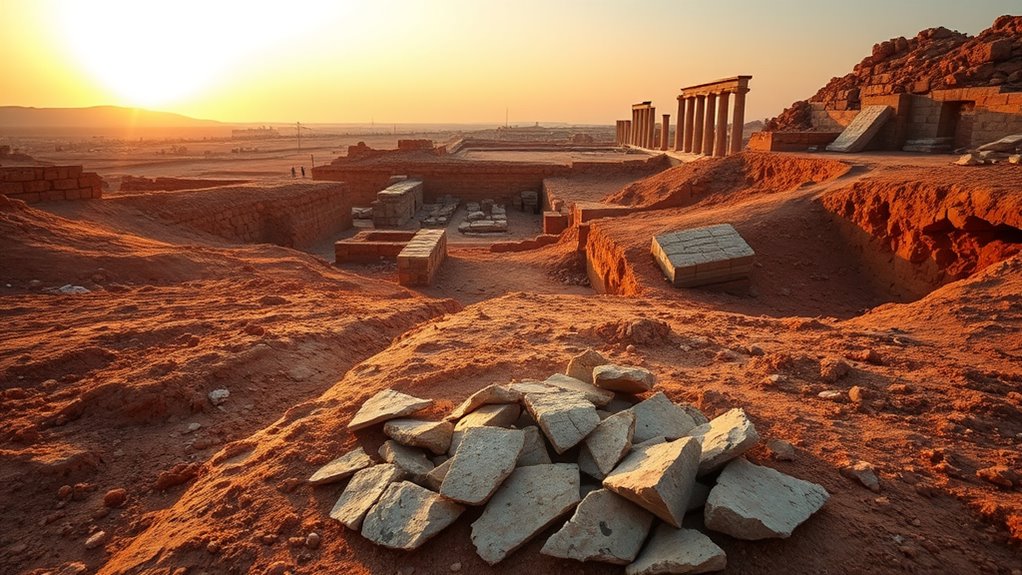
You can find archaeological evidence confirming the locations of many biblical cities and the events that took place there. Recent discoveries support the historical accuracy of stories you’ve read about. These finds help connect the biblical narrative to tangible, ancient sites and artifacts.
Confirmed City Locations
Have archaeologists pinpointed the precise locations of biblical cities through excavations and discoveries? In many cases, yes. Ancient inscriptions found at various sites provide direct evidence linking archaeological locations to biblical cities, confirming their historical existence. Artifact preservation plays a vital role, helping researchers identify city boundaries and settlement patterns. Well-preserved artifacts like pottery, tools, and inscriptions help establish accurate site locations. For example, excavations at Jericho and Ai have uncovered evidence supporting their biblical sites. While some locations remain debated, ongoing discoveries increasingly verify the biblical map. These findings bolster confidence that archaeology can confirm the physical locations of many biblical cities, offering tangible proof that supports the historical reliability of scripture.
Event Archaeological Finds
Archaeological discoveries do more than confirm city locations; they also provide direct evidence of biblical events. Excavations have uncovered ancient artifacts that align with biblical accounts, offering tangible links to historical moments. For example, the discovery of inscriptions and artifacts related to the Israelites’ conquest of Jericho supports the biblical narrative. These finds often reveal cultural practices, shedding light on daily life, religious rituals, and societal structure during biblical times. Such evidence helps verify the historicity of events described in the Bible, making the connection between archaeology and scripture more concrete. By examining these artifacts and their context, you gain a clearer understanding of how ancient peoples lived and how their history aligns with biblical stories.
Discoveries That Challenge Biblical Chronology
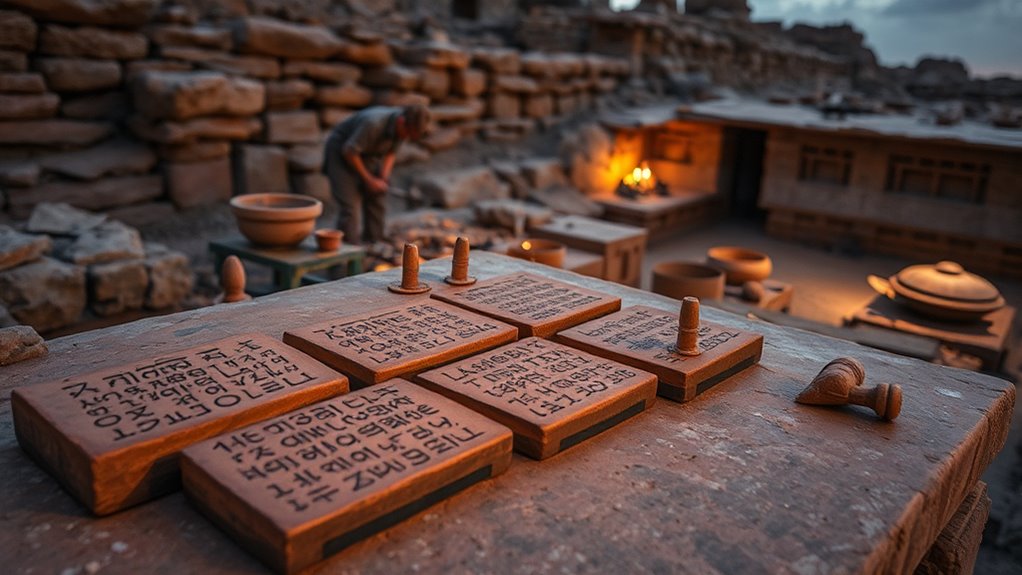
Some discoveries in archaeology have raised questions about the chronological timelines presented in the Bible. For example, the analysis of ancient pottery often reveals dates that don’t align with biblical timelines, suggesting different periods of occupation or cultural development. Inscriptions analysis also plays a key role; inscriptions sometimes mention events or rulers that conflict with biblical chronologies. These findings can challenge traditional timelines, prompting scholars to re-examine assumptions about the order and timing of biblical events. While not outright dismissing biblical accounts, such discoveries encourage a more nuanced understanding of history. By studying these artifacts carefully, you may find that the archaeological record offers a complex picture, sometimes supporting, sometimes challenging, the biblical chronology.
The Role of Archaeology in Validating Biblical Figures
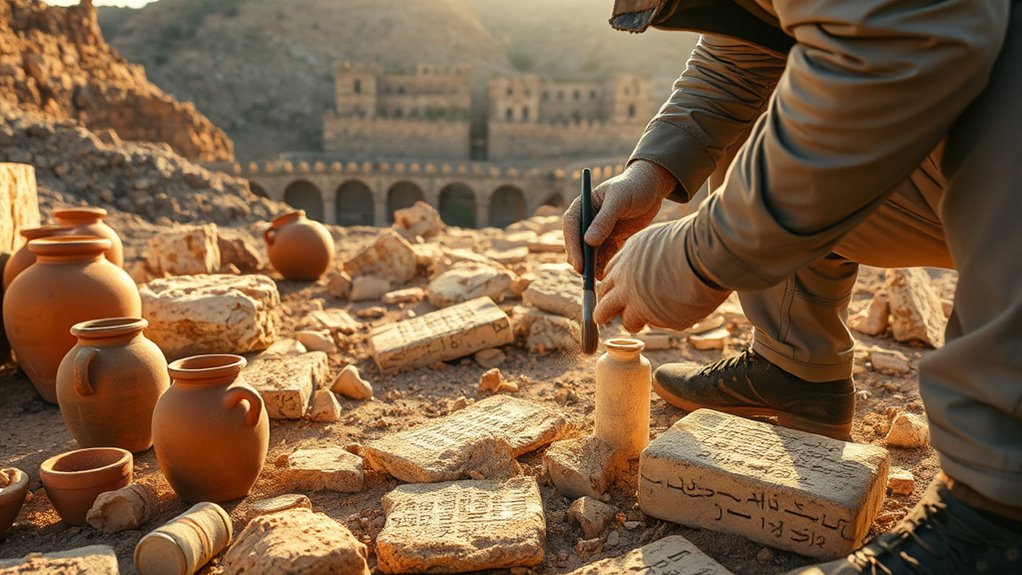
Discoveries in archaeology have increasingly contributed to confirming the existence of biblical figures, lending historical weight to stories long considered religious tradition. Ancient artifacts and references in historical texts provide tangible evidence that these figures may have truly lived. For example, the discovery of inscriptions mentioning King David supports his biblical portrayal as a historical leader. Similarly, artifacts like the Tel Dan Stele and sealed seals bearing Hebrew names reinforce the existence of figures such as Hezekiah and other kings. These findings help bridge the gap between faith and history, offering you archaeological validation of biblical characters. While interpretations vary, such discoveries strengthen the argument that many biblical figures were real people whose lives left marks on history.
Controversies and Limitations of Archaeological Support
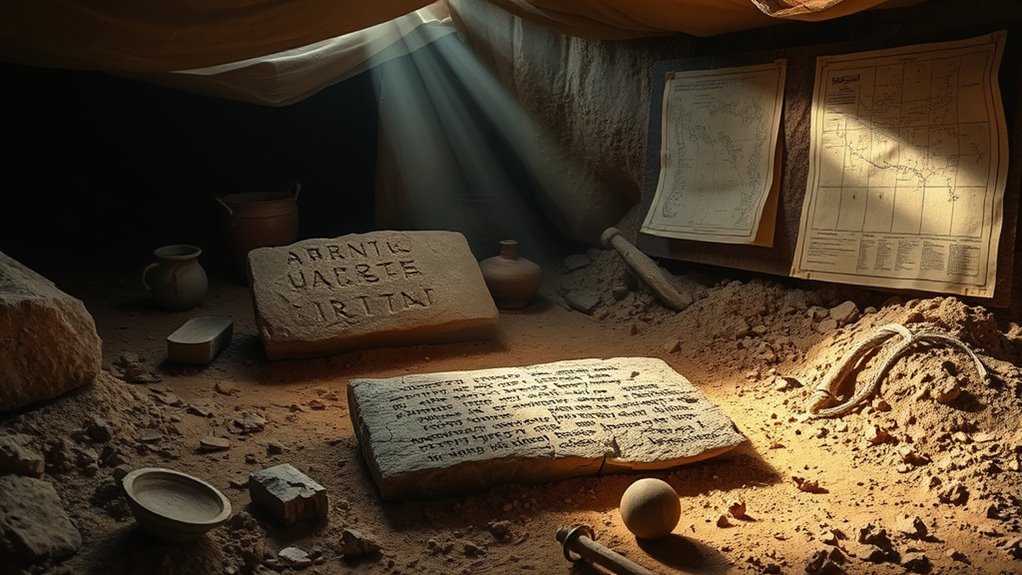
Although archaeological findings can support biblical claims, they often spark controversy and face significant limitations. One major issue is dating challenges, where establishing precise timelines remains difficult due to incomplete or ambiguous evidence. Without accurate dates, linking artifacts directly to biblical events becomes problematic. Additionally, interpretative biases can influence how findings are viewed, with scholars sometimes seeing what they want to see rather than what the evidence truly indicates. These biases can lead to conflicting conclusions about the biblical relevance of certain artifacts. Furthermore, archaeological discoveries are often fragmentary, making it hard to form definitive connections. As a result, while archaeology can offer valuable insights, it’s important to recognize its limitations and the controversies they can generate in the quest to support biblical history.
How Archaeological Findings Shape Biblical Understanding
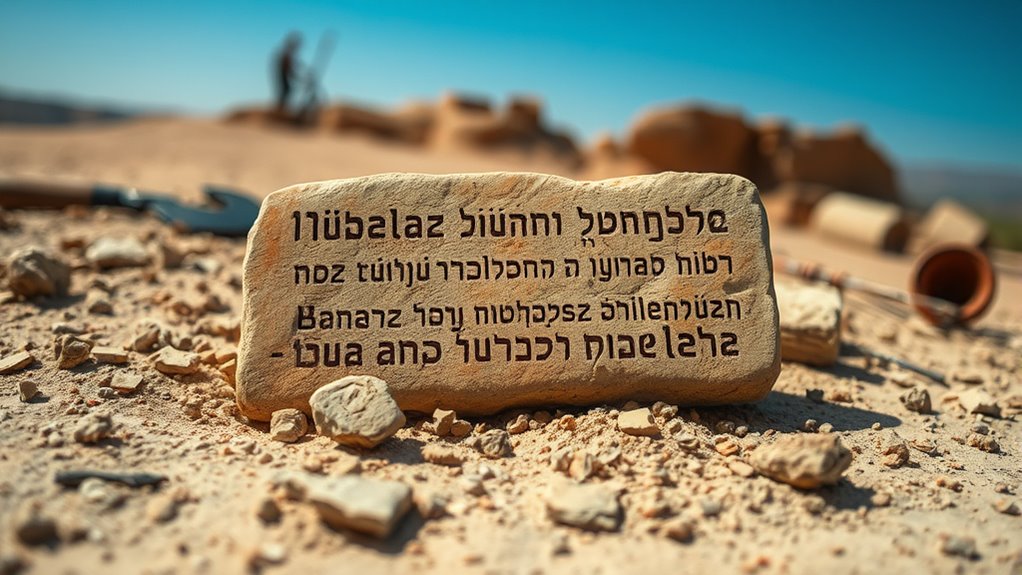
Archaeological findings have substantially influenced how you interpret the stories and events described in the Bible. Through artifact analysis and advanced dating techniques, scholars can verify or challenge biblical accounts. For example, discovering inscriptions or pottery helps confirm the existence of ancient cities mentioned in scripture. Dating techniques, such as radiocarbon analysis, determine the age of artifacts, aligning them with biblical timelines. This process can:
- Validate historical references
- Clarify cultural contexts
- Enhance your understanding of biblical events
Frequently Asked Questions
How Does Archaeology Impact Modern Biblical Translations?
You see that archaeology impacts modern biblical translations by providing valuable insights from ancient inscriptions and cultural artifacts. These discoveries help translators understand historical contexts, language nuances, and cultural references, making translations more accurate and meaningful. When you consider archaeological findings, you gain a clearer picture of biblical times, which allows you to interpret texts with greater precision and authenticity, enriching your understanding of the scriptures.
What Are the Ethical Concerns in Biblical Archaeological Excavations?
Think of biblical excavations as delicate gardening—you must nurture artifacts carefully. Ethical concerns revolve around artifact preservation and excavation ethics, ensuring you respect cultural heritage and avoid destruction. You’re responsible for maintaining integrity, preventing looting, and sharing findings transparently. If you neglect these principles, it’s like tearing through a garden, destroying its beauty and history. Upholding ethical standards safeguards the past for future generations and honors the stories these artifacts tell.
Can Archaeology Prove the Existence of God or Divine Intervention?
You wonder if archaeology can prove divine intervention or validate faith. While archaeological discoveries can support historical events described in religious texts, they can’t definitively prove God’s existence or divine actions. You should see archaeology as a tool that enriches your understanding of biblical history, but faith remains a personal belief that transcends empirical evidence. Ultimately, archaeology offers context, not absolute proof of divine intervention.
How Do Archaeological Findings Influence Religious Faith and Beliefs?
Have you ever wondered how archaeological findings shape your beliefs? They provide essential historical context and highlight the cultural significance of ancient events and sites. These discoveries can deepen your understanding of faith, affirming traditions or challenging assumptions. While they may not prove spiritual truths, archaeology influences your beliefs by connecting you to the past, helping you see the enduring impact of faith across civilizations and inspiring reflection on your own spiritual journey.
Are There Ongoing Excavations That Could Change Biblical Understanding?
You’ll find that ongoing excavations at dig site discoveries continue to uncover ancient artifacts that could reshape biblical understanding. Researchers actively explore areas linked to biblical stories, and new finds might provide fresh insights or challenge existing interpretations. These discoveries keep the field dynamic, and while they may not definitively prove or disprove religious texts, they certainly fuel ongoing debates and deepen our knowledge of ancient history and its connection to biblical accounts.
Conclusion
Archaeology has confirmed over 20 key biblical sites, offering compelling evidence for many events and figures. While some discoveries support biblical accounts, others challenge traditional timelines, keeping debates alive. Notably, around 70% of biblical cities mentioned in ancient texts have been identified through archaeological finds. This ongoing dialogue between archaeology and scripture deepens your understanding of biblical history, reminding you that faith and evidence often intertwine in fascinating ways.

